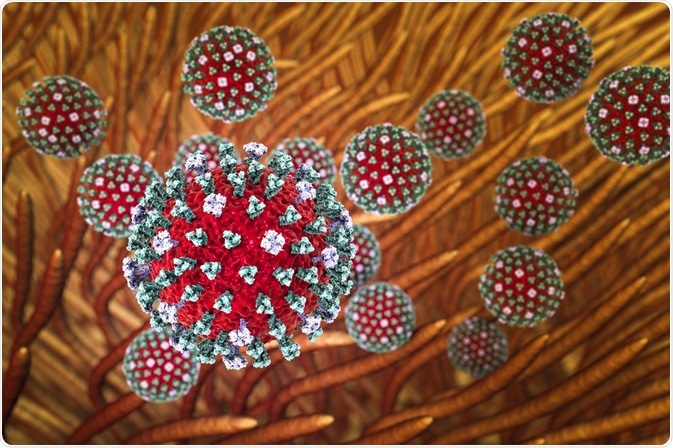Influenza virus is a common cause of human respiratory infection with a high rate of morbidity and mortality, particularly in the elderly and in infants.

Influenza A belongs to the Orthomyxoviridae family. It has a negative sense RNA genome encoding 11 viral genes, contained within a viral envelope. The viral genes are as follows:
- hemagglutinin (HA)
- neuraminidase (NP)
- matrix 1 (M1)
- matrix 2 (M2)
- nucleoprotein (NP)
- non-structural protein (NSP1)
- non-structural protein 2/nuclear export protein (NS2/NEP)
- polymerase acidic protein (PA)
- polymerase basic protein 1 (PB1)
- polymerase basic protein 2 (PB2)
- polymerase basic protein 1-F2 (PB1-F2)
Entry into the cell
The virus can have a variety of shapes, but is most commonly spherical. It begins entering a host cell when spikes formed by HA on the surface of the virus bind to sialic acid on the surface of the host cell. The binding of HA to sialic acid is highly species specific.
Humans have a different specificity from horses and birds. However, swine viruses recognize both, which makes swine an effective mixing vessel for avian, equine, and human influenza A virus.
Once the virus has bound to the host sialic acid, the cell undergoes receptor-mediated endocytosis and the virus enters the cell inside an endosome. The low pH (around 5 to 6) within the endosome triggers fusion of viral and endosomal membranes. A conformational change occurs in one of the subunits of HA, exposing the HA2 fusion peptide, which inserts itself into the endosomal membrane. That brings the viral and endosomal membranes into contact.
Viral release and replication
The acidic environment of the endosome also opens the M2 ion channel, which acidifies the viral core. The acidic environment within the viral particle releases viral ribonucleoproteins (vRNPs), which are then free to enter the cytoplasm of the host cell.
Influenza virus replicates its genome inside the nucleus. Once the vRNP is released into the cytoplasm, its constituent proteins NP, PA, PB1 and PB2 bind to cellular nuclear import machinery and enter the nucleus.
Replication of the viral genome
In order for the influenza A genome to be transcribed, it must be converted into positive sense RNA. This enables the genome to become a template for production of viral RNAs. Viral RNA dependent RNA polymerase initiates RNA synthesis on the viral RNA.
A “cap snatching” process is carried out by viral endonuclease (PB2) to modify the RNA, which is then used as a primer for transcription of protein PB1, a viral transcriptase. Eight positive sense RNA strands are synthesized from the eight negative sense genes. The RNA is then exported from the nuclease into the cytoplasm of the host cell.
In the cytoplasm, hemagglutinin and neuraminidase undergo glycosylation, polymerization, and acylation. With M2, these proteins migrate to the plasma membrane and with M1 begin the process of budding. The eight RNA segments are transported to the budding site, and the virus particle buds from the cell surface.
The final step is cleavage of the sialic acid receptors on the membrane, which frees the virus from the cell, into the extracellular environment.
Flu Attack! How A Virus Invades Your Body | Krulwich Wonders | NPR
Further Reading